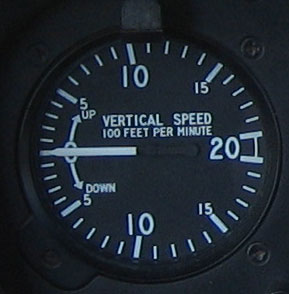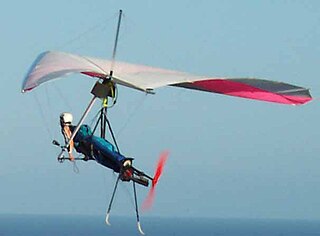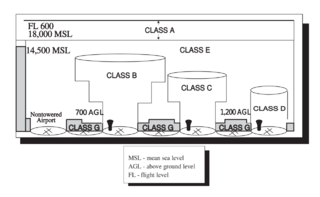
Hang gliding is an air sport or recreational activity in which a pilot flies a light, non-motorised, heavier-than-air aircraft called a hang glider. Most modern hang gliders are made of an aluminium alloy or composite frame covered with synthetic sailcloth to form a wing. Typically the pilot is in a harness suspended from the airframe, and controls the aircraft by shifting body weight in opposition to a control frame.

In aviation, a variometer – also known as a rate of climb and descent indicator (RCDI), rate-of-climb indicator, vertical speed indicator (VSI), or vertical velocity indicator (VVI) – is one of the flight instruments in an aircraft used to inform the pilot of the rate of descent or climb. It can be calibrated in metres per second, feet per minute or knots, depending on country and type of aircraft. It is typically connected to the aircraft's external static pressure source.

Wind shear, sometimes referred to as wind gradient, is a difference in wind speed and/or direction over a relatively short distance in the atmosphere. Atmospheric wind shear is normally described as either vertical or horizontal wind shear. Vertical wind shear is a change in wind speed or direction with a change in altitude. Horizontal wind shear is a change in wind speed with a change in lateral position for a given altitude.
Aviation is the design, development, production, operation, and use of aircraft, especially heavier-than-air aircraft. Articles related to aviation include:

Speed to fly is a principle used by soaring pilots when flying between sources of lift, usually thermals, ridge lift and wave. The aim is to maximize the average cross-country speed by optimizing the airspeed in both rising and sinking air. The optimal airspeed is independent of the wind speed, because the fastest average speed achievable through the airmass corresponds to the fastest achievable average groundspeed.
Dynamic soaring is a flying technique used to gain energy by repeatedly crossing the boundary between air masses of different velocity. Such zones of wind gradient are generally found close to obstacles and close to the surface, so the technique is mainly of use to birds and operators of radio-controlled gliders, but glider pilots are sometimes able to soar dynamically in meteorological wind shears at higher altitudes.

In aeronautics, the rate of climb (RoC) is an aircraft's vertical speed, that is the positive or negative rate of altitude change with respect to time. In most ICAO member countries, even in otherwise metric countries, this is usually expressed in feet per minute (ft/min); elsewhere, it is commonly expressed in metres per second (m/s). The RoC in an aircraft is indicated with a vertical speed indicator (VSI) or instantaneous vertical speed indicator (IVSI).

Ultralight aircraft exist outside of the United States. In most countries, ultralights are a class of aircraft. A completely different legal concept is valid within the USA. The FAA makes explicitly clear, that ultralight vehicles are no aircraft, are not regulated as aircraft, and are exempt from aircraft rules. Instead, they are treated as powersport items and have to follow their own ruleset, FAR-103, which is the most compact aviation regulation in existence. It can be printed on the front- and backside of a single piece of paper.
The Gliding Federation of Australia (GFA), also known as Gliding Australia, is the governing body for the sport of gliding in Australia. It was founded in 1949. The GFA is responsible to Civil Aviation Safety Authority for the conduct of safe gliding operations in Australia. This includes the setting and maintenance of flying standards and in particular training standards, for gliding and soaring flight in heavier-than-air fixed-wing gliders and sailplanes, powered sailplanes and touring motor gliders, but excluding flexible wing, weight shift hang gliders and paragliders.

A foot-launched powered hang glider (FLPHG), also called powered harness, nanolight, or hangmotor, is a powered hang glider harness with a motor and propeller in pusher configuration. An ordinary hang glider is used for its wing and control frame, and the pilot can foot-launch from a hill or from flat ground, needing a length of about a football field to get airborne, or much less if there is an oncoming breeze and no obstacles.

The United States airspace system's classification scheme is intended to maximize pilot flexibility within acceptable levels of risk appropriate to the type of operation and traffic density within that class of airspace – in particular to provide separation and active control in areas of dense or high-speed flight operations.

The International Gliding Commission (IGC) is the international governing body for the sport of gliding. It is governed by meetings of delegates from national gliding associations.

Paul F. Bikle was director of the U.S. National Aeronautics and Space Administration (NASA) Dryden Flight Research Facility from 1959 until 1971, and author of more than 40 technical publications. He was associated with major aeronautical research programs including the hypersonic X-15 rocket plane, and was a world record-setting glider pilot.

The yaw string, also known as a slip string, is a simple device for indicating a slip or skid in an aircraft in flight. It performs the same function as the slip-skid indicator ball, but is more sensitive, and does not require the pilot to look down at the instrument panel. Technically, it measures sideslip angle, not yaw angle, but this indicates how the aircraft must be yawed to return the sideslip angle to zero.
Gliding flight is heavier-than-air flight without the use of thrust; the term volplaning also refers to this mode of flight in animals. It is employed by gliding animals and by aircraft such as gliders. This mode of flight involves flying a significant distance horizontally compared to its descent and therefore can be distinguished from a mostly straight downward descent like a round parachute.

In aviation, V-speeds are standard terms used to define airspeeds important or useful to the operation of all aircraft. These speeds are derived from data obtained by aircraft designers and manufacturers during flight testing for aircraft type-certification. Using them is considered a best practice to maximize aviation safety, aircraft performance, or both.
Richard H. Johnson was a glider pilot, aeronautical engineer and prolific writer of articles for gliding magazines. He was an 11-time U.S. National Champion glider pilot, 9-time US Soaring Team pilot at the Soaring World Championships, held two World Gliding Records and is a member of the US Soaring Hall of Fame. He flew for 70 years and logged over 14,000 flying hours, including over 10,000 hours of non-powered flight time in sailplanes. He authored over 100 articles on soaring and flight tests of gliders.

Gliding is a recreational activity and competitive air sport in which pilots fly unpowered aircraft known as gliders or sailplanes using naturally occurring currents of rising air in the atmosphere to remain airborne. The word soaring is also used for the sport.

A glider or sailplane is a type of glider aircraft used in the leisure activity and sport of gliding. This unpowered aircraft can use naturally occurring currents of rising air in the atmosphere to gain altitude. Sailplanes are aerodynamically streamlined and so can fly a significant distance forward for a small decrease in altitude.

Richmond Field is a privately owned, public use airport. It is located two nautical miles (4 km) southeast of the central business district of Gregory, a city in Livingston County, Michigan, United States.














